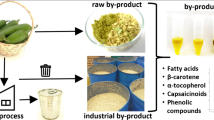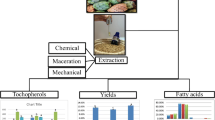Abstract
Yield and composition of seed oil (SO) from eight variants of prickly pear were evaluated. Oil extraction was performed by maceration-percolation (MP) and by cold press (CP). Characterization and quantification of fatty acids and phytosterols was performed by CG/EM. Cytotoxicity and proliferative activities in vitro of the extracted SO were evaluated on fibroblast cell culture. Oil yield was quite variable between variants, higher with MP method (6.2–15.5%) than with CP method (0.5–6.1%). Oil analysis from the eight variants revealed the predominance (mg/g) of linoleic acid (664.5–761.0 and 605.4–787.8), followed by oleic acid (92.7–198.8 and 115.2–199.4), palmitic acid (25.6–56.2 and 2.9–6.1), and stearic acid (15.5–36.1 and 2.9–5.2) for CP and MP respectively. Regarding phytosterols, β-sitosterol was predominant (11.6–58.3 mg/100 g of seed), over γ-tocopherol (16.6–23.8 mg/100 g of seeds) for MP and CP, respectively. By adding 50 µM of CP oil, cell death due to UV radiation of human dermic fibroblasts was reduced. Prickly pear seed, as a residue of the juice industry, contain compounds with potential commercial value.


Similar content being viewed by others
References
Glampedaki, P., Dutschk, V.: Stability studies of cosmetic emulsions prepared from natural products such as wine, grape seed oil and mastic resin. Colloid Surf. A 460, 306–311 (2014). https://doi.org/10.1016/j.colsurfa.2014.02.048
El Monfalouti, H., Guillaume, D., Denhez, C., Charrouf, Z.: Therapeutic potential of argan oil: a review. J. Pharm. Pharmacol. 62, 1669–1675 (2010). https://doi.org/10.1111/j.2042-7158.2010.01190.x
Reyes-Agüero, J.A., Aguirre-Rivera, J.R., Flores-Flores, J.L.: Variación morfológica de Opuntia (Cactaceae) en relación con su domesticación en la Altiplanicie Meridional de México. Interciencia 30, 476–484 (2005)
Reyes-Agüero, J.A., Aguirre-Rivera, J.R., Carlín-Castelán, F., González-Durán., A.: Catálogo de las principales variantes silvestres y cultivadas de Opuntia en la Altiplanicie Meridional de México. UASLP, San Luis Potosí (2009)
Reyes-Agüero, J.A., Aguirre-Rivera, J.R.: Agrobiodiversity of cactus pear (Opuntia, Cactaceae) in the Meridional Highlands Plateau of México. JNRD 1, 1–8 (2011). https://doi.org/10.5027/jnrd.v1i0.01
García-Pedraza, L.G., Reyes-Agüero, J.A., Aguirre-Rivera, J.R., Pinos-Rodríguez, J.M.: Preliminary nutritional and organoleptic assessment of xoconostle fruit (Opuntia spp.) as a condiment or appetizer. Ital. J. Food Sci. 17(3), 333–340 (2005)
Astello-García, M.G., Santos-Díaz, M.S., Reyes-Agüero, J.A., Barba de la Rosa, A.P.: Opuntia spp. as a source of bioactive compounds, In: Tunick, M. (Ed.) Hispanic Foods: Chemistry and Bioactive Compounds: ACS Symposium Series, vol. 8, pp. 101–111. ACS Publishing, Washington, DC (2012)
Galati, E.M., Mondello, M.R., Giuffrida, D., Dugo, G., Miceli, N., Pergolizzi, S., Taviano, M.F.: Chemical characterization and biological effects of Sicilian Opuntia ficus indica (L.) Mill. fruit juice: antioxidant and antiulcerogenic activity. J. Agric. Food Chem. 51, 4903–4908 (2003). https://doi.org/10.1021/jf030123d
Stintzing, F.C., Herbach, K.M., Mosshammer, M.R., Carle, R., Yi, W., Sellappan, S., Akoh, C., Bunch, R., Felker, P.: Color, betalain pattern, and antioxidant properties of cactus pear (Opuntia spp.) clones. J. Agric. Food Chem. 53, 442–451 (2005). https://doi.org/10.1021/jf048751y
Zenteno-Ramírez, G., Juárez-Flores, B.I., Aguirre-Rivera, J.R., Ortiz-Pérez, M.D., Zamora-Pedraza, C., Rendón-Huerta, J.A.: Evaluación de azúcares y fibra soluble en el jugo de variantes de tunas (Opuntia spp.). Agrociencia 49(2), 141–152 (2015)
Sáenz, C.: Utilización de los frutos del nopal en productos alimenticios. In: Rosell, C. (ed.), Utilización Agroindustrial del Nopal, pp. 31–50. Organización de las Naciones Unidas para la Agricultura y la Alimentación, Rome (2006)
Cardador-Martínez, A., Jiménez-Martínez, C., Sandoval, G.: Revalorization of cactus pear (Opuntia spp.) wastes as a source of antioxidants. Food Sci. Tech. 31, 782–788 (2011)
Mirabella, N., Castellani, V., Sala, S.: Current options for the valorization of food manufacturing waste: a review. J. Clean. Prod. 65, 28–41 (2014). https://doi.org/10.1016/j.jclepro.2013.10.051
Da Silva, A.C., Jorge, N.: Bioactive compounds of the lipid fraction of agroindustrial waste. Food Res. Int. 66, 493–500 (2014)
Habibi, Y., Mahrouz, M., Vignon, M.R.: Arabinan-rich polysaccharides isolated and characterized from the endosperm of the seed of Opuntia ficus-indica prickly pear fruits. Carbohydr. Polym. 60, 319–329 (2005)
NMX, NMX-FF-030-SCFI-2006 Productos Alimenticios no Industrializados para Uso Humano - Fruta Fresca - Tuna (Opuntia spp.) Especificaciones. (1995) http://www.sagarpa.gob.mx/agronegocios/Lists/Instrumentos%20Tcnicos%20Normalizacin%20y%20Marcas%20Colecti/Attachments/121/NMX_TUNA.pdf
Ortiz-Moreno, A., Dorantes, L., Galíndez, J., Guzmán, R.I.: Effect of different extraction methods on fatty acids, volatile compounds, and physical and chemical properties of avocado (Persea americana Mill.) oil. J. Agric. Food Chem. 51(8), 2216–2221 (2003). https://doi.org/10.1021/jf0207934
Ghasemzadeh-Mohammad, V., Mohammadi, A., Hashemi, M., Khaksara, R., Haratian, P.: Microwave-assisted extraction and dispersive liquid–liquid microextraction followed by gas chromatography–mass spectrometry for isolation and determination of polycyclic aromatic hydrocarbons in smoked fish. J. Chromatogr. 1237(11), 30–36 (2012). https://doi.org/10.1016/j.chroma.2012.02.078
Jasso-Padilla, I., Juárez-Flores, B.I., Alvarez-Fuentes, G., De la Cruz-Martínez, A., González-Ramírez, J., Moscosa-Santillán, M., González-Chávez, M.M., Oros-Ovalle, C., Prell, F., Czermakd, P., Martinez-Gutierrez, F.: Effect of prebiotics of Agave salmiana fed to healthy Wistar rats. J. Sci. Food Agric. 97, 556–563 (2017). https://doi.org/10.1002/jsfa.7764
Grajales-Lagunes, A., García-Muñoz, M.S., González-Chávez, M.M., Loredo-García, I.O., Ruiz-Cabrera, M.A.: Chemical composition and fatty acids profile supports the use of edible ant eggs (Liometopum apiculatum Mayr) in human nutrition. Wulfenia J. 24(3), 110–122 (2017)
Statistical Analysis System (SAS Institute): 9.2. User’s guide: statistics [CD/ROM Coputer fule]. (8th versión). Cary, NC (2002)
Morales, P., Ramírez-Moreno, E., Sánchez-Mata, M.C., Carvalho, A.M., Ferreira, I.C.: Nutritional and antioxidant properties of pulp and seeds of two xoconostle cultivars (Opuntia joconostle F.A.C. Weber ex Diguet and Opuntia matudae Scheinvar) of high consumption in México. Food Res. Int. 46, 279–285 (2012). https://doi.org/10.1016/j.foodres.2011.12.031
Chougui, N., Tamendjari, A., Hamidj, W., Hallal, S., Barras, A., Richard, T., Larbat, R.: Oil composition and characterization of phenolic compounds of Opuntia ficus-indica seeds. Food Chem. 139, 796–803 (2013). https://doi.org/10.1016/j.foodchem.2013.01.054
Matthaüs, B., Özcan, M.M.: Habitat effects on yield, fatty acid composition and tocopherol contents of prickly pear (Opuntia ficus-indica L.) seed oils. Sci. Hortic. 131, 95–98 (2011). https://doi.org/10.1016/j.scienta.2011.09.027
El Mannoubi, I., Barrek, S., Skanji, T., Casabianca, H., Zarrouk, H.: Characterization of Opuntia ficus indica seed oil from Tunisia. Chem. Nat. Compd. 45, 616–620 (2009). https://doi.org/10.1007/s10600-009-9448-1
Ennouri, M., Evelyne, B., Laurence, M., Hamadi, A.: Fatty acid composition and rheological behavior of prickly pear seed oils. Food Chem. 93, 431–437 (2005). https://doi.org/10.1016/j.foodchem.2004.10.020
Ramadan, M.F., Mörsel, J.T.: Oil cactus pear (Opuntia ficus-indica L.). Food Chem. 82, 339–345 (2003). https://doi.org/10.13140/2.1.2980.2565
Labuschagne, M.T., Hugo, A.: Oil content and fatty acid composition of cactus pear seed compared with cotton and grape seed. J. Food Biochem. 34, 93–100 (2010). https://doi.org/10.1111/j.1745-4514.2009.00266.x
Bockisch, M.: Fats and Oils Handbook. AOAS Press, Urbana (1998)
Choi, Y.-S., Ji-HunChoi, Doo-JeongHan, Kim, H.-Y., Lee, M.-A., Kim, H.-W., Lee, J.-W., Chung, H.-J., Kim, C.-J.: Optimization of replacing pork back fat with grape seed oil and rice bran fiber for reduced-fat meat emulsion systems. Meat Sci. 84(1), 212–218 (2010). https://doi.org/10.1016/j.meatsci.2009.08.048
Carta, G., Murru, E., Banni, S., Manca, C.: Palmitic acid: physiological role, metabolism and nutritional implications. Front. Phys. 8, 1–14 (2017)
Ghazi, Z., Ramdani, M., Fauconnier, M.L., El Mahi, B., Cheikh, R.: Fatty acids sterols and vitamin E composition of seed oil of Opuntia ficus-indica and Opuntia dillenii from Morocco. J. Mat. Environ. Sci. 4, 967–972 (2013)
Zine, S., Gharby, S., El Hadek, M.: Physicochemical characterization of Opuntia ficus-indica seed oil from Morocco. Biosci. Biotech. Res. Asia 10, 1–7 (2013). https://doi.org/10.17660/ActaHortic.2015.1067.11
Wagemaker, T.A.L., Carvalho, C.R.L., Maia, N.B., Baggio, S.R., Guerreiro-Filho, O.: Sun protection factor, content and composition of lipid fraction of green coffee beans. Ind. Crop Prod. 33, 469–473 (2011). https://doi.org/10.1016/j.indcrop.2010.10.026
Wagemaker-Tais, A.L., Silas, A.M., Silva-Gislaine, R., Leonardi, M.B.G., Campos, M.: Green Coffea arabica L. seed oil influences the stability and protective effects of topical formulations. Ind. Crop Prod. 63, 34–40 (2015). https://doi.org/10.1016/j.indcrop.2014.09.045
Acknowledgements
This work was supported by Fundación Produce, Grant: 90721. E. Regalado-Rentería had a MS scholarship from Consejo Nacional de Ciencia y Tecnología (CONACyT), Grant: 559072.
Author information
Authors and Affiliations
Corresponding author
Ethics declarations
Conflict of interest
The authors have declared no conflict of interest.
Rights and permissions
About this article
Cite this article
Regalado-Rentería, E., Aguirre-Rivera, J.R., González-Chávez, M.M. et al. Assessment of Extraction Methods and Biological Value of Seed Oil from Eight Variants of Prickly Pear Fruit (Opuntia spp.). Waste Biomass Valor 11, 1181–1189 (2020). https://doi.org/10.1007/s12649-018-0409-4
Received:
Accepted:
Published:
Issue Date:
DOI: https://doi.org/10.1007/s12649-018-0409-4




